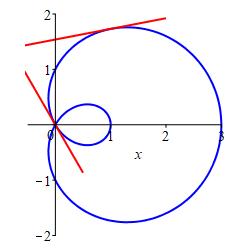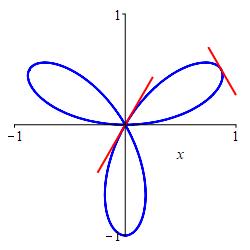15. Polar Coordinates
Polar Curve as a Parametric Curve
Notice that any polar curve \(r=f(\theta)\) can be regarded as a parametric curve with parameter \(\theta\) and coordinate functions: \[ x(\theta)=r\cos\theta=f(\theta)\cos\theta \qquad \qquad y(\theta)=r\sin\theta=f(\theta)\sin\theta \] Normally, we remove the reference to \(f\), writing \(r=r(\theta)\) and: \[ x(\theta)=r(\theta)\cos\theta \qquad \qquad y(\theta)=r(\theta)\sin\theta \] Then the position vector of the curve is \[ \vec{r}(\theta)=(x(\theta),y(\theta)) =(r(\theta)\cos\theta,r(\theta)\sin\theta) \]
\(\vec r(\theta)\) is the position vector (Notice the arrow over the \(\vec r\).) telling us the position in the plane for each value of the parameter \(\theta\), whereas \(r(\theta)\) is simply the function defining the polar curve. Don't get confused.
We will use this formulation in two of our applications of polar curves: slope and arclength.
c. Slope of a Polar Graph
Recall that the slope of a parametric curve \(\vec{r}(\theta)=(x(\theta),y(\theta))\) is: \[ \dfrac{dy}{dx} =\dfrac {\;\dfrac{dy}{d\theta}\;} {\;\dfrac{dx}{d\theta}\;} \] In fact, applying the product rule to a polar curve gives: \[\begin{aligned} \dfrac{dx}{d\theta} &=\dfrac{dr}{d\theta}\cos\theta-r(\theta)\sin\theta\\ \dfrac{dy}{d\theta} &=\dfrac{dr}{d\theta}\sin\theta+r(\theta)\cos\theta \end{aligned}\] Consequently:
The slope of a polar curve \(r=r(\theta)\) is \[ \dfrac{dy}{dx} =\dfrac {\;\dfrac{dr}{d\theta}\sin\theta+r(\theta)\cos\theta\;} {\;\dfrac{dr}{d\theta}\cos\theta-r(\theta)\sin\theta\;} \] provided the denominator is non-zero.
Caution: Remember, \(\dfrac{dy}{d\theta}\) is in the numerator and \(\dfrac{dx}{d\theta}\) is in the denominator. It is easy to get these backwards.
Find the slope of the limacon \(r=1+2\cos\theta\) at:
- \(\theta=\dfrac{\pi}{3}\)
- \(\theta=\dfrac{2\pi}{3}\)
Notice that \(\theta=\dfrac{2\pi}{3}\) is a point where the curve passes through the origin since \(\cos\dfrac{2\pi}{3}=\dfrac{-1}{2}\) and \(r=1+2\left(\dfrac{-1}{2}\right)=0\).

Since \(\dfrac{dr}{d\theta}=-2\sin\theta\), the slope is \[\begin{aligned} \dfrac{dy}{dx} &=\dfrac{-2\sin\theta\sin\theta+(1+2\cos\theta)\cos\theta} {-2\sin\theta\cos\theta-(1+2\cos\theta)\sin\theta} \\ \end{aligned}\]
- At \(\theta=\dfrac{\pi}{3}=60^\circ\), \(\sin\theta=\dfrac{\sqrt{3}}{2}\) and \(\cos\theta=\dfrac{1}{2}\). So: \[\begin{aligned} \left.\dfrac{dy}{dx}\right|_{\theta=\pi/3} &=\dfrac{\;-2\left(\frac{\sqrt{3}}{2}\right)\left(\frac{\sqrt{3}}{2}\right) +\left(1+2\left(\frac{1}{2}\right)\right)\left(\frac{1}{2}\right)\;} {\;-2\left(\frac{\sqrt{3}}{2}\right)\left(\frac{1}{2}\right) -\left(1+2\left(\frac{1}{2}\right)\right)\left(\frac{\sqrt{3}}{2}\right)\;} \\ &=\dfrac{\;-\,\frac{3}{2}+1\;}{\;-\,\frac{\sqrt{3}}{2}-\sqrt{3}\;} =\dfrac{-\,\frac{1}{2}}{-\,\frac{3\sqrt{3}}{2}}=\dfrac{1}{3\sqrt{3}} \end{aligned}\]
- At \(\theta=\dfrac{2\pi}{3}=120^\circ\), \(\sin\theta=\dfrac{\sqrt{3}}{2}\) and \(\cos\theta=\dfrac{-1}{2}\). So: \[\begin{aligned} \left.\dfrac{dy}{dx}\right|_{\theta=2\pi/3} &=\dfrac{\;-2\left(\frac{\sqrt{3}}{2}\;\right)\left(\frac{\sqrt{3}}{2}\right) +\left(1+2\left(-\,\frac{1}{2}\right)\right)\left(-\,\frac{1}{2}\right)\;} {\;-2\left(\frac{\sqrt{3}}{2}\right)\left(-\,\frac{1}{2}\right) -\left(1+2\left(-\,\frac{1}{2}\right)\right)\left(\frac{\sqrt{3}}{2}\right)\;} \\ &=\dfrac{\;-\frac{3}{2}+0\;}{\;\frac{\sqrt{3}}{2}-0\;} =\dfrac{-3}{\sqrt{3}}=-\sqrt{3} \end{aligned}\]
In this example, notice that \(\tan\dfrac{2\pi}{3}=-\sqrt{3}\) which is the slope at \(\theta=\dfrac{2\pi}{3}\). This is no coincidence. Look at the figure. Notice that the curve comes into the origin tangent to the line \(\theta=\dfrac{2\pi}{3}\) and the slope of that line is \(\tan\dfrac{2\pi}{3}\).
If \(\theta=\theta_o\) is a point where the polar curve \(r=r(\theta)\) passes through the origin, i.e. \(r(\theta_o)=0\), then the slope at \(\theta=\theta_o\) is: \[ \left.\dfrac{dy}{dx}\right|_{\theta=\theta_o}=\tan\theta_o \]
At \(\theta=\theta_o\), \(r(\theta_o)=0\). So \[\begin{aligned} \left.\dfrac{dy}{dx}\right|_{\theta=\theta_o} &=\dfrac {\;\dfrac{dr}{d\theta}(\theta_o)\sin\theta_o+r(\theta_o)\cos\theta_o\;} {\;\dfrac{dr}{d\theta}(\theta_o)\cos\theta_o-r(\theta_o)\sin\theta_o\;} \\ &=\dfrac {\;\dfrac{dr}{d\theta}(\theta_o)\sin\theta_o\;} {\;\dfrac{dr}{d\theta}(\theta_o)\cos\theta_o\;} =\tan\theta_o \end{aligned}\]
Find the slope of the 3-leaf rose \(r=\sin3\theta\) at:
-
\(\theta=\dfrac{\pi}{6}\)
-
\(\theta=\dfrac{\pi}{3}\)

\(\left.\dfrac{dy}{dx}\right|_{\theta=\pi/6}=-\sqrt{3}\)
Since \(\dfrac{dr}{d\theta}=3\cos3\theta\), the slope is: \[ \dfrac{dy}{dx} =\dfrac{3\cos3\theta\sin\theta+\sin3\theta\cos\theta} {3\cos3\theta\cos\theta-\sin3\theta\sin\theta} \] At \(\theta=\dfrac{\pi}{6}=30^\circ\): \[ \sin\theta=\dfrac{1}{2}, \qquad \cos\theta=\dfrac{\sqrt{3}}{2}, \qquad \sin3\theta=1, \qquad \cos3\theta=0 \] So: \[ \left.\dfrac{dy}{dx}\right|_{\theta=\pi/6} =\dfrac{\cos\theta}{-\sin\theta} =\dfrac {\;\dfrac{\sqrt{3}}{2}\;}{\;\dfrac{-1}{2}\;} =-\sqrt{3} \]
Notice that \(\theta=\dfrac{\pi}{3}\) is a point where the curve passes through the origin.
\(\left.\dfrac{dy}{dx}\right|_{\theta=\pi/3}=\sqrt{3}\)
Since \(\theta=\dfrac{\pi}{3}\) is a point where the curve passes through the origin: \[ \left.\dfrac{dy}{dx}\right|_{\theta=\pi/3} =\tan\dfrac{\pi}{3}=\sqrt{3} \]
Heading
Placeholder text: Lorem ipsum Lorem ipsum Lorem ipsum Lorem ipsum Lorem ipsum Lorem ipsum Lorem ipsum Lorem ipsum Lorem ipsum Lorem ipsum Lorem ipsum Lorem ipsum Lorem ipsum Lorem ipsum Lorem ipsum Lorem ipsum Lorem ipsum Lorem ipsum Lorem ipsum Lorem ipsum Lorem ipsum Lorem ipsum Lorem ipsum Lorem ipsum Lorem ipsum